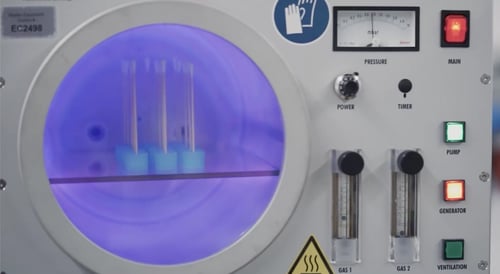As mentioned previously,
dry etching and wet etching are the two main types of etching. Wet etching includes multiple chemical reactions. It involves the following three steps:
- Diffusion of the liquid etchant to the material (that needs to be etched)
- Reaction between the liquid etchant and the material
- Desorption of the byproducts from the surface
An example of dry etching is plasma etching. Plasma etching in plasma etching systems involves the following six steps:
- Production of the reactive species in a plasma
- Diffusion of the reactive species onto the material’s surface
- Adsorption of the reactive species onto the material’s surface
- Reaction (chemical) between reactive species and material that forms volatile byproducts
- Desorption of the volatile byproducts
- Diffusion of these byproducts into the bulk gas and expelled through vacuum system.
Dyne Levels and Plasma Etching Technologies
Plasma technologies can increase the surface energy of materials. The dyne levels reveal the surface wettability. As the dyne level increases, the wettability and adhesion of the material increases as well. Free surface energy has to be much greater than the surface tension of the liquid (by a recommended level of at least 2 to 10 dynes) in order to achieve good wettability. The different ways to measure wettability include measuring the contact angle or by using Dyne test solutions. Dyne solutions are fast and easy to use. After applying a thin layer of the dyne solution to the material, if beads of the solution form, then it indicates that the surface energy of the material is lower than the dyne level of the Dyne solution. Plastics generally have lower surface energies due to less available bonding sites, meaning that it is difficult for liquids to wet out on the surface. Wetting the surface is necessary to glue plastics to other objects or to paint the plastic’s surface. If a good wettability is not achieved, the objects may lose adhesion. Another way to improve bonding is to use plasma etching with a plasma etching machine. As a result, Plasma etching increases the surface area of the material and increases bonding.

